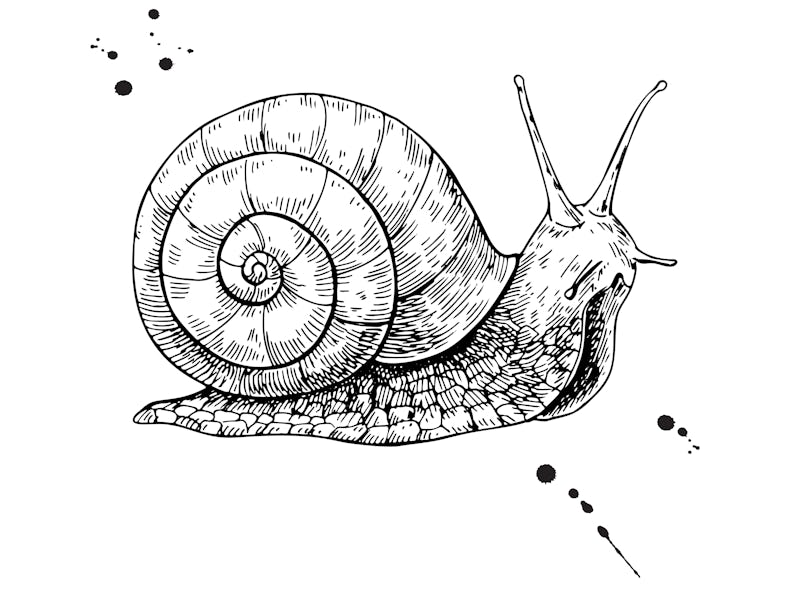Rare snail makes science history thanks to international hunt for a mate
Jeremy the snail left behind a genetic legacy.

Jeremy the snail wasn't like most of his fellow gastropods. His particularly unique spiraled shell has left a mark on science history.
Discovered in 2016 in London, Jeremy immediately stood out to researchers. Most garden snail shells spiral toward the right if you look at the center of their shell and follow the outward path. But Jeremy had a shell that spiraled toward the left — a highly unusual trait.
Scientists wanted to know why and were particularly interested in whether the answer was rooted in snail genes. In a new study, geneticists report the answer: The left-spiraling shell is a quirk of nature, not an inherited trait.
The finding was published Tuesday in the journal Biology Letters.
To get to that conclusion, the team had one very difficult task: They had to find Jeremy a girlfriend. To see whether or not his shell was a result of genetics or chance, Jeremy had to have some babies.
But because of the ways snails put their bodies together to procreate, Jeremy's mate also had to have a left-spiraling shell, allowing both snails' genitals to line up on the same side.
Left: typical right-spiraling (dextral) snail. Right: Jeremy.
The problem was that snails like Jeremy are incredibly rare — literally one in a million.
So Angus Davison, a professor of evolutionary genetics at the University of Nottingham, sent out a plea to snail enthusiasts asking for them to get in touch if they discovered a matching snail.
The media pitched in: The BBC put out a call and PBS posted a video asking viewers to "Help a Snail Find True Love!"
Jeremy even got his own Twitter handle to spread the word, using the hashtag #snaillove.
With the help of the internet, Davison's team was able to round up a handful of potential snail mates and introduced them to Jeremy the snail — named after left-leaning British politician Jeremy Corbyn, who's also a big gardener.
Leaving behind a lineage — Jeremy the snail died in 2017. But first, he left behind a genetic legacy that sheds light on what made him different from most other snails.
A lefty snail Jeremy had mated with produced 56 babies. One-third of those snail kids are believed to be Jeremy's.
With a few exceptions, most of the offspring produced by all of the left-spiraling snails actually spiraled to the right. That means that having a left-spiraling, or sinistral, shell is an accidental phenomenon rather than a trait that can be inherited.
Top: Jeremy, a sinistral (left-spiraling) snail. Bottom: a more typical, dextral (right-spiraling) snail.
"We helped solve one of nature's puzzles, which was very satisfying," Davison said in a statement.
"There was also a happy ending for Jeremy, the snail, in finding love and producing offspring, albeit just before dying."
The finding adds to an ongoing debate among scientists about why asymmetry happens in the first place. Leading theories suggest that it's the result of a protein network within cells called a cytoskeleton — which cause asymmetry within cells themselves, and seem to lay the groundwork for an asymmetrical body.
Down the road, Davison says, a better understanding of the underlying reasons for asymmetry "may help us understand how the right and left side of other animal bodies are defined, including ourselves."
Abstract: While animal bodies are typically bilaterally symmetric on the outside, the internal organs nearly always show an invariant left–right (LR) asymmetry. In comparison, snails are both internally and externally LR asymmetric, outwardly obvious in the shell coiling direction, or chirality. Although some species of snail are naturally variable for chirality, sinistral individuals occur very rarely in most species. The developmental and genetic basis of these rare mirror-imaged individuals remains mysterious. To resolve this issue, the finding of a ‘one in a million’ sinistral garden snail called ‘Jeremy’ was used to recruit citizen scientists to find further sinistral snails. These snails were then bred together to understand whether their occurrence is due an inherited condition. The combined evidence shows that rare sinistral garden snails are not usually produced due to a major effect maternal Mendelian locus. Instead, they are likely mainly produced by a developmental accident. This finding has relevance to understanding the common factors that define cellular and organismal LR asymmetry, and the origin of rare reversed individuals in other animal groups that exhibit nearly invariant LR asymmetry